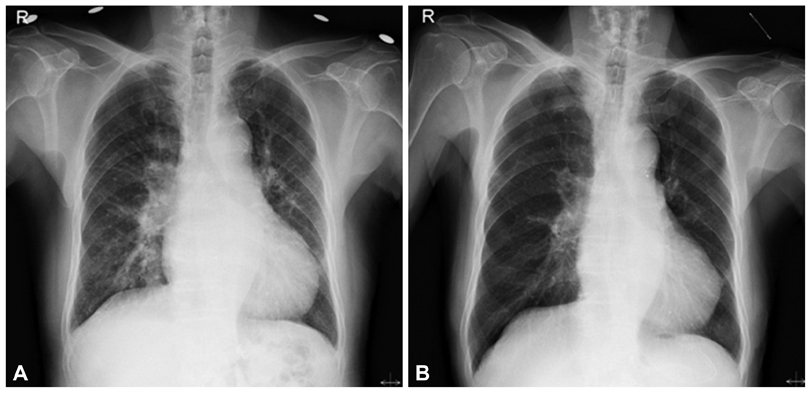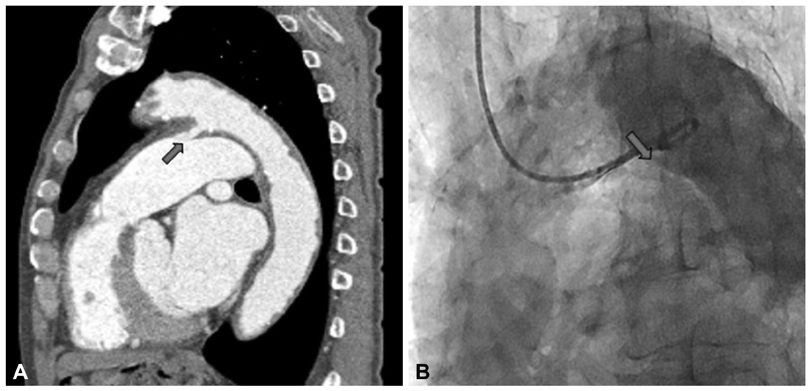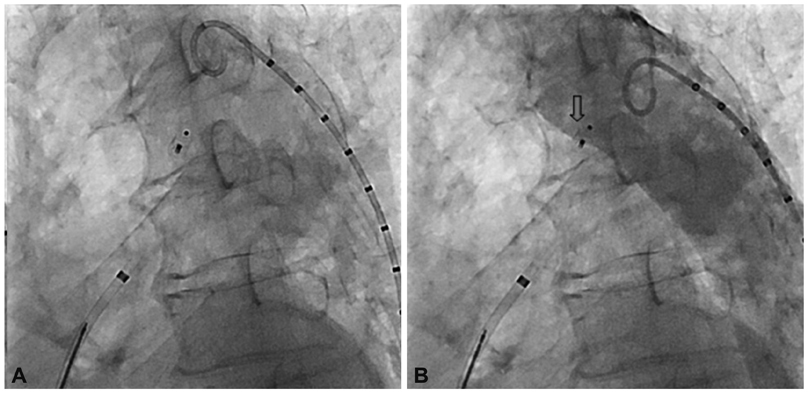Korean Circ J.
2012 Dec;42(12):849-852. 10.4070/kcj.2012.42.12.849.
A Case of Patent Ductus Arteriosus with Congestive Heart Failure in a 80-Year-Old Man
- Affiliations
-
- 1Division of Cardiology, Daejeon St. Mary's Hospital, The Catholic University of Korea College of Medicine, Seoul, Korea. hhhsungho@naver.com
- 2Division of Thoracic Surgery, Daejeon St. Mary's Hospital, The Catholic University of Korea College of Medicine, Seoul, Korea.
- KMID: 1491102
- DOI: http://doi.org/10.4070/kcj.2012.42.12.849
Abstract
- Patent ductus arteriosus (PDA) is a rare clinical finding in adult patients. Considering the increase in cases of PDA discovered incidentally on echocardiograms at young ages, and the life-shortening effect of PDA, it is rare to diagnose PDA in old patients. We report a case of an 80-year-old patient who experienced symptoms of congestive heart failure showed findings suggestive of PDA in echocardiogram and confirmed the diagnosis through a cardiac catheterization and a coronary angiography. After percutaneous occlusion of PDA with an Amplatzer duct occlusion device, symptoms related to congestive heart failure improved.
Keyword
MeSH Terms
Figure
Reference
-
1. Akintunde AA, Opadijo OG. Case report of a 26 year old primigravida with patent ductus arteriosus (PDA) in heart failure. Afr Health Sci. 2011. 11:138–140.2. Cassidy HD, Cassidy LA, Blackshear JL. Incidental discovery of a patent ductus arteriosus in adults. J Am Board Fam Med. 2009. 22:214–218.3. Satoh T, Yanagitani Y, Okano Y. Patent ductus arteriosus with combined valvular disease at age 91. Intern Med. 1997. 36:340–344.4. Satoh T, Nishida N. Patent ductus arteriosus with infective endocarditis at age 92. Intern Med. 2008. 47:263–268.5. Zhu XY, Chen HY, Zhang DZ, et al. Effects of transcatheter closure of patent ductus arteriosus in 139 adult patients. Zhonghua Xin Xue Guan Bing Za Zhi. 2009. 37:998–1000.6. Wang JK, Wu MH, Hwang JJ, Chiang FT, Lin MT, Lue HC. Transcatheter closure of moderate to large patent ductus arteriosus with the Amplatzer duct occluder. Catheter Cardiovasc Interv. 2007. 69:572–578.7. Harrison DA, Benson LN, Lazzam C, Walters JE, Siu S, McLaughlin PR. Percutaneous catheter closure of the persistently patent ductus arteriosus in the adult. Am J Cardiol. 1996. 77:1094–1097.8. Giliberti P, De Leonibus C, Giordano L, Giliberti P. The physiopathology of the patent ductus arteriosus. J Matern Fetal Neonatal Med. 2009. 22:Suppl 3. 6–9.
- Full Text Links
- Actions
-
Cited
- CITED
-
- Close
- Share
- Similar articles
-
- Aneurysm after Surgical Ligation of Patent Ductus Arteriosus: A Case Report
- Nonsurgical closure of patent ductus arteriosus with the rashkind PDA occluder system
- Frontal cardiac area in patent ductus arteriosus patients
- Surgical treatment of patent ductus arteriosus in preterm and infants with severe heart failure and cardiac cachexia
- LPA Occulusion Due to the Erroneous Ligature of Patent Ductus Arteriosus: a report of 3 cases




